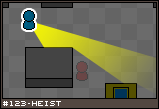 | Posted: 06/17/11
One player attempts to shine a spotlight on another, hidden player. |
![[heist1.png]](set07/img/entry123-heist1.png)
Fig 123-1. A Night In the Museum.
This is a two player game where one player plays a thief attempting to steal an exhibit from a museum in the dark. The other player play multiple guard simultaneously, shining their flashlights in an attempt to find the thief. This game is intended to be played with a modern game console controller, as it requires two analog sticks and some sort of rumble capability.
![[heist2.png]](set07/img/entry123-heist2.png)
Fig 123-2. Patrol Routes.
The player that plays as the security guards controls two guards simultaneously. Each guard moves automatically according to a visible, unique patrol path while the player controls the direction of the flashlight with one analog stick per guard. So, the player is using the two analog sticks to simultaneously search the museum from two different vantage points.
The player never directly controls the guards, but he can control the speed of each guard using the two analog triggers. Squeeze a little bit and the guard slows down. Squeeze it all the way and the guard stops. The other two non-analog triggers (LB/RB on 360, L1/R1 on PS3) will cause the guard to start walking in the opposite direction along his patrol route.
If the guard manage to spot the thief using their flashlights, the guards will blow their whistles and start running toward the location the thief was seen, using the shortest, most direct path there. The player does not control the guards, but still aims the flashlights, so as long as the guards keep the thief in their sight, they will pursue him. The guards move slightly faster than the thief. If either guard gets within a short range of the thief, they'll pull out their tasers and shock the thief into submission, winning the round.
If the guards arrive at the position where the thief was last seen and can not find him again, they will wander back to their patrol route and continue where they left off.
![[heist3.png]](set07/img/entry123-heist3.png)
Fig 123-3. False Positives.
The thief is a semi-transparent unit that can move around of his own free will. Since his opponent will be looking at the same screen, obviously, it would be very easy to find the thief. As such, there will be multiple AI thieves wandering around in the dark as well. These represent sounds and distractions that the guards might investigate. Shining their flashlight on a distraction will make it disappear (a new one will spawn somewhere else in a few seconds).
The thief can use this to move around and find his own surroundings occasionally, but it is not the best way to travel. By holding down the trigger, the thief becomes completely invisible. The player can not see his thief, but instead navigates through the use of the rumble function of the controller. As the thief gets near a wall, the controller will start to rumble a little. When near a major obstacle or dangerous element, it will rumble a lot. The player can navigate the environment by knowing which direction he is moving and how close he is to a wall or obstacle. If a guard shines a light on the invisible thief, he is revealed - though he can become invisible again as soon as he escapes the light.
The thief's goal is simply to capture the treasure chest in the level. Of course, it's never that easy.
Each museum level is filled with traps and obstacles that the thief needs to overcome before he can steal the treasure:
![[ost1.png]](set07/img/entry123-ost1.png)
Security Cameras / Motion Detectors -
The guards' patrol routes can't cover the entire map. There might be automated security cameras that sweep across these corners, or motion detectors which go off if a thief goes within a certain radius of the sensor. Being fully invisible will not set off these devices. Setting them off will cause the nearest security guard to come investigate.
![[ost2.png]](set07/img/entry123-ost2.png)
Laser Alarms -
There are lasers going across the floor that the thief will trip if he steps into them. Lasers will have control panels from which the thief can turn them off. These control panels take about 10 seconds to activate, during which time the thief is visible and vulnerable to being flashlighted.
![[ost3.png]](set07/img/entry123-ost3.png)
Low Obstacles -
Low obstacles, like boxes, do not obscure the thief from the flashlight if he is standing up. However, if he is in sneak mode (invisible), he is considered ducking and cannot be seen by the flashlights behind low obstacles.
![[ost4.png]](set07/img/entry123-ost4.png)
Mirrors -
Mirrors can reflect light around corners, allowing the guards to increase their search area. The thief may turn the mirror so it doesn't work. If the guard stops his patrol and focuses his light on a non-working mirror for a couple seconds, the guard will walk over to the mirror and set it back correctly.
|